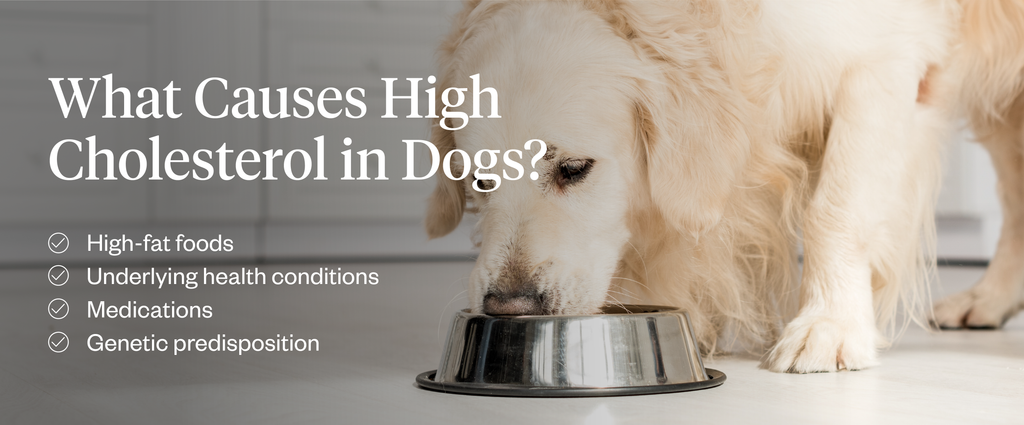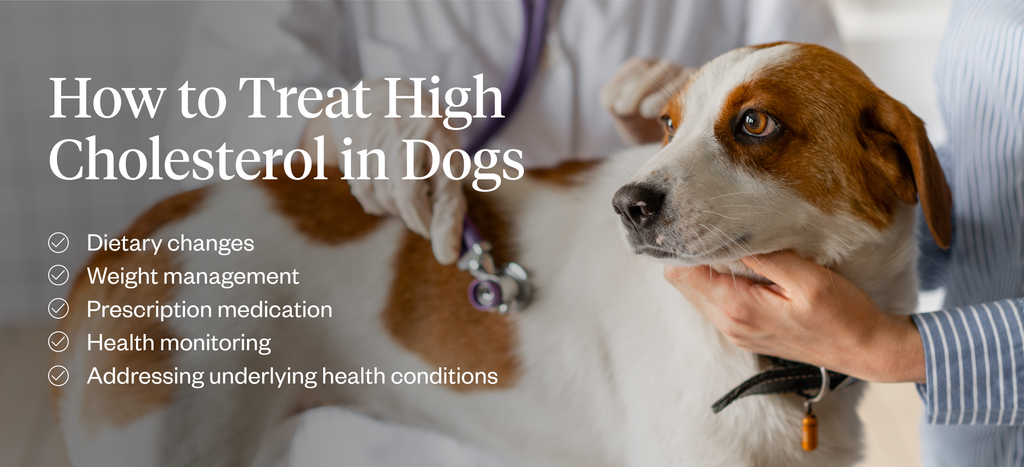11 Min Read
High Cholesterol in Dogs: Symptoms, Causes & Treatment
Key takeaway

Why pet owners are switching to online vet care with Dutch
-
Prescriptions delivered free to you
-
Fast access to Licensed Vets over video
-
Unlimited video visits and follow-ups
Just like humans, our beloved canine companions can experience high cholesterol. While we often associate high cholesterol with our own dietary choices and lifestyle, our furry companions are not immune to this potentially dangerous health concern.
The presence of elevated cholesterol in dogs can pose a range of risks, affecting their overall well-being and longevity. High cholesterol in dogs is a potential health hazard that requires a keen understanding. Just as in humans, persistently high cholesterol in dogs can lead to a variety of complications. But what causes high cholesterol in dogs? Recognizing the signs and addressing the root causes are crucial steps in preventing the potential dangers associated with high cholesterol.
Keep reading to learn more about high cholesterol in dogs, its symptoms, causes, and risks.
- Symptoms of High Cholesterol in Dogs
- Causes of High Cholesterol in Dogs
- Risks of High Cholesterol in Dogs
- Diagnosing & Treating Cholesterol in Dogs
- How to Prevent High Cholesterol in Dogs
- Final Notes
Symptoms of High Cholesterol in Dogs
Hyperlipidemia, also known as high cholesterol in dogs, comes with symptoms that can indicate potential health issues. This health issue is characterized by abnormally elevated levels of fat and fatty substances in the blood, and high cholesterol can come with symptoms such as:
- Seizures: Dogs with high cholesterol may experience seizures, which are abnormal and uncontrolled bursts of electrical activity in the brain. These seizures can vary in intensity and duration.
- Abdominal pain: Hyperlipidemia can cause abdominal discomfort in dogs. This pain may manifest as restlessness, reluctance to be touched or picked up, or a change in posture.
- Nervous system dysfunction: Elevated levels of cholesterol may impact the nervous system, leading to various dysfunctions. This can include changes in behavior, coordination issues, or abnormal neurological signs.
- Skin patches: High cholesterol levels in dogs may lead to patches of hair loss on the skin. These patches can be indicative of underlying metabolic or dermatological issues associated with hyperlipidemia.
- Cutaneous xanthomata: One of the more distinctive signs of hyperlipidemia is the development of cutaneous xanthomata. These are yellowish-orange bumps on the skin filled with fatty, greasy liquid. 1

Causes of High Cholesterol in Dogs
High cholesterol in dogs occurs when there are elevated levels of fat molecules, including cholesterol and triglycerides, circulating in the blood. 2 In healthy animals, lipid levels typically rise after a meal and then return to normal levels. However, hyperlipidemia occurs when excess fat persists in the bloodstream due to certain conditions, preventing the return to normal levels. 2
High cholesterol in dogs is often secondary to underlying disorders like diabetes mellitus, hypothyroidism, Cushing’s disease, certain liver diseases, and protein-losing nephropathy – a condition that involves the abnormal loss of proteins through the kidneys into the urine.
High cholesterol can also be caused by diet. What foods cause high cholesterol in dogs? Eating high-fat foods, especially table scraps, can lead to spontaneous high cholesterol in dogs. Certain medications, such as corticosteroids, can also contribute to elevated cholesterol levels. 2
Certain dog breeds, including miniature schnauzers, beagles, Shetland sheepdogs, briards, rough collies, and poodles, are predisposed to hyperlipidemia. However, high blood cholesterol can manifest in any breed. 2
Risks of High Cholesterol in Dogs
It’s important to note that high cholesterol doesn’t predispose dogs to heart and blood vessel disease as it does in humans. 3 However, it does pose several risks and can contribute to various health issues. Some risks associated with high cholesterol in dogs include:
- Pancreatitis: Hyperlipidemia is a recognized risk factor for pancreatitis in dogs. Pancreatitis is the inflammation of the pancreas and can be a painful and serious condition. Dogs with high cholesterol levels may be more susceptible to pancreatitis. 4
- Skin conditions: High cholesterol levels can manifest in skin issues for dogs. It may contribute to the development of xanthomas beneath the skin. These bumps can be unsightly and may cause discomfort for the dog.
- Neurological symptoms: In severe cases, high cholesterol in dogs can lead to neurological symptoms in dogs. This may include seizures, abnormal behavior, and other nervous system dysfunctions.
- Underlying disease: High cholesterol in dogs is typically a secondary condition associated with another underlying health issue. Diseases like diabetes mellitus, hypothyroidism, and Cushing’s disease can contribute to elevated cholesterol levels.
- Reduced lifespan and quality of life: If left untreated, the risks associated with high cholesterol can contribute to a reduced lifespan and decreased quality of life for affected dogs. Chronic health issues can impact their overall well-being.
Diagnosing & Treating Cholesterol in Dogs
If you suspect your dog has high cholesterol, it’s crucial to consult a vet. Your vet will begin the diagnostic process with a thorough physical examination and medical history. To assess the extent of high cholesterol, your dog will likely need to be hospitalized for a fast lasting twelve or more hours. Following the fasting period, your vet will use diagnostic tests to evaluate the lipid profile and rule out underlying diseases. 1 These tests may include the following:
- Chemical blood profile: Provides detailed information about various blood components, including cholesterol and triglyceride levels.
- Complete blood count (CBC): Assesses the overall health of your dog by examining different blood cell types.
- Serum sample for biochemical analysis: Analyzes blood serum for biochemical marketers related to lipid metabolism.
- Urinalysis: Examines urine to identify any abnormalities that may indicate kidney or metabolic issues. 1

Once diagnosed, managing hyperlipidemia in dogs involves addressing underlying causes and implementing lifestyle modifications. Here’s how to treat high cholesterol in dogs:
- Dietary changes: A specialized diet with reduced fat content may be recommended to manage lipid levels. Feeding smaller, more frequent meals can also aid in digestion.
- Weight management: Maintaining a healthy weight is crucial, as obesity is often associated with high cholesterol in dogs. Your vet may provide guidance on an appropriate weight management plan.
- Medications: In some cases, medications such as fibrates or niacin may be prescribed to help regulate lipid levels. Your veterinarian will determine the most suitable treatment based on your dog’s specific condition.
- Monitoring: Regular follow-up visits to the veterinarian will be essential to monitor your dog’s progress. Repeat blood tests may be conducted to assess the effectiveness of the treatment plan.
- Address underlying health issues: Knowing how to treat high cholesterol in dogs is important. However, if it’s caused by an underlying health condition, treating the cause will treat the symptom. If hyperlipidemia is secondary to underlying diseases, treating these conditions will be a key aspect of the overall management strategy.
How to Prevent High Cholesterol in Dogs
Preventing high cholesterol in dogs involves proactive measures to maintain their overall health and address lifestyle factors that contribute to lipid imbalances. Here are a few key strategies to prevent high cholesterol in dogs:
- Balanced nutrition: Provide a well-balanced and nutritionally appropriate diet for your dog. Choose high-quality dog food that meets their specific dietary needs.
- Low-fat diet: Select dog food options that are lower in fat content. Consult with your vet to determine the ideal fat intake based on your dog’s breed, age, and health status. Avoid feeding your pet excessive table scraps or high-fat treats, as these can contribute to high cholesterol. If you must share a snack with your pet, consider healthier options such as celery , carrots, or even apple slices.
- Regular exercise: Maintain a regular exercise routine for your dog to promote cardiovascular health and prevent obesity. Activities like daily walks, play sessions, and interactive games keep your dog physically active.
- Weight management: Monitor your dog’s weight and body condition regularly. Obesity is a risk factor for hyperlipidemia. Adjust the feeding portions and calorie intake based on your dog’s energy needs to prevent excessive weight gain.
- Avoid high-fat treats: Limit the intake of high-fat treats, as they can contribute to an imbalance in lipid levels. Choose healthier treat options or consult your vet for diet and nutrition advice .
- Regular vet checkups: Schedule regular checkups with your veterinarian to monitor your dog’s overall health.
- Address underlying conditions: Since high cholesterol can be a symptom of another condition, it’s crucial to take care of your dog’s overall health. If your dog has underlying health conditions such as diabetes or hypothyroidism, work closely with your vet to manage these conditions effectively. Treating and controlling contributing factors can help prevent high cholesterol.

Final Notes
Recognizing the symptoms, understanding the causes, and being aware of the risks of high cholesterol in dogs is crucial for pet parents. While high cholesterol in dogs doesn’t predispose them to heart disease like it does in humans, it can lead to serious health issues.
If you believe your dog has high cholesterol, seeking veterinary advice is essential. As you prioritize your dog’s health, consider the convenience of Dutch telemedicine for pets. With remote consultations, you can access veterinary care, discuss symptoms, and receive guidance on your dog’s health. Embrace the ease of online appointments, prescription delivery, and unlimited follow-ups to ensure your canine companion receives the best possible care. Try Dutch today.Share
References
-
“High Cholesterol in Dogs.” PetMD, www.petmd.com/dog/conditions/endocrine/c_multi_hyperlipidemia.
-
“Hyperlipidemia in Dogs and Cats.” VIN, veterinarypartner.vin.com/default.aspx?pid=19239&id=4952698.
-
“Understanding Your Pet’s Lab Tests.” Veterinary Teaching Hospital, 12 Jan. 2022, hospital.vetmed.wsu.edu/2022/01/12/understanding-your-pets-lab-tests/.
-
Xenoulis, Panagiotis G, et al. “Serum Triglyceride and Cholesterol Concentrations and Lipoprotein Profiles in Dogs with Naturally Occurring Pancreatitis and Healthy Control Dogs.” Journal of Veterinary Internal Medicine, U.S. National Library of Medicine, Mar. 2020, www.ncbi.nlm.nih.gov/pmc/articles/PMC7097643/.
